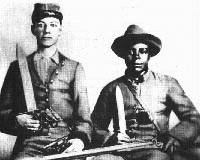Conclusion
It seems that the best case that can be made for large numbers of colored Confederates is based on sloppy evidence that cannot and does not convince the large majority of historians. Many of the accounts that the promotors of black Confederates rely on are ambiguous, partisan, or the result of revisionism in history. Sometimes, however, Rollins et al misrepresent the testimonies made, such as ascribing loyalty to a slave who may just fear for his hide, or by referring to blacks as "Afro-Virginians."
 These untrained historians too easily derive favorable
conclusions from unclear sources and are sincerely under
the impression that they honor a large group that has
unjustly been left out of the major historiography,
motivated, it seems, by a union of reconciliation and
racial awareness of earlier historiographical periods.
Their remedy is the production of books and articles,
backed up by faulty scholarship, which lead to the
conclusion that large numbers of loyal blacks must have
accompanied the Southern armies and have actively handled
rifles.
These untrained historians too easily derive favorable
conclusions from unclear sources and are sincerely under
the impression that they honor a large group that has
unjustly been left out of the major historiography,
motivated, it seems, by a union of reconciliation and
racial awareness of earlier historiographical periods.
Their remedy is the production of books and articles,
backed up by faulty scholarship, which lead to the
conclusion that large numbers of loyal blacks must have
accompanied the Southern armies and have actively handled
rifles.
A factor in the accumulation of such a number may be the fact that the accounts of fighting slaves have been concentrated into a growing number of essays, thus adding to the notion that there must have been a significant body of them. The scattered fractions of accounts and indications were a much more realistic representation of the amount of blacks fighting; indeed, one might say fighting blacks were as scattered and obscure as the sources initially were.
Now, most laymen are not historians and are much more easily persuaded by the face value of documents, especially when compiled into such neat volumes as the one published by Segars and Barrow. They are, in addition, often swayed by a present feeling of nationalism or regional pride, which blurs skepticism. Thus the faulty scholarship serves as an important source for annotation in online essays that promote the notion that thousands of blacks did fight along with their grandfathers, and that, indeed, the Civil War was not about slavery after all. Not necessarily does the South rise again, but apologia for the Lost Cause, for the Old South, proliferates, and it soothes national memory.
Those championing an increase in the alotted number of colored Confederates, concluding that the Confederacy was worth fighting for by blacks, forget that often even white people were moved to war by much less honorable motives than the Cause for the preservation of Old South values. Indeed, it seems that blacks fought mainly out of self-interest and of care for their family.
Although the promotions of false notions is regrettable, there is something to be said for an increased attention for the forgotten, loyal blacks. Indeed, if anything can be learned from the testimonies and sources, it is that blacks are not to be treated as a monolithic group that automatically sided with the North. Also, a careful professional approach of the issue can serve to educate people and correct the wrongful interpretation of this element in history. Therefore, a solid case can be made to give more attention to this obscure corner in history.
If The Littlest Rebel was pervaded with racist depictions of blacks and slaves, the portrayal of Holt, the colored character in Ride with the Devil, is one of the more distinguished accounts of Southern blacks in movies. As a former slave, he fights alongside his old neighbor and long time friend for the South in Missouri. When his friend dies, Holt admits that his entire purpose of fighting has dissipated, clarifying that he did not fight for the South perse, but out of loyalty to the one who bought his freedom. All of which seems perfectly balanced from a historical viewpoint.
Perhaps professional historians can learn from popular culture and dig into interesting stories that have taken place in the margins of history. This may, in turn, influence other, large productions in popular culture, such as The Last Full Measure, the final sequel to Gods and Generals and Gettysburg, two films that both largely ignored the many cooks and servants accompanying the army of Northern Virginia.(43) Who knows, it might even feature a few black companies at the end of the war-though they will not be given orders by a colonel with blonde curls and blue ribbons.
